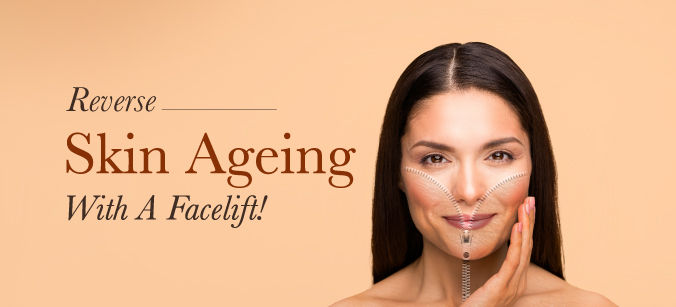Skin Care
Reverse Skin Ageing With A Facelift! Read Everything About It
3 min read
By Apollo 24|7, Published on - 24 April 2023, Updated on - 01 July 2023
Share this article
0
1 like

We all have the desire to look youthful all through our life. However, ageing is an inevitable phenomenon that affects most of us. While you may think getting your young face back is impossible, facelifts can help rejuvenate your skin delivering you a more natural appearance. In this article, we are going to discuss its definition, benefits and the process involved in it.
What Is A Facelift?
Also known as Rhytidectomy, a facelift is a type of cosmetic surgery that helps improve the visual ageing signs of your face and your neck. It adds a fresh glow to your face by repositioning or removing old skin, fat or muscle. However, facelifts cannot fundamentally change your appearance or stop the ageing process indefinitely. They also cannot treat superficial wrinkles, damage caused by the sun or skin colour abnormality.
What Are The Benefits Of A Facelift?
Facelifts are extremely effective in making your skin look more youthful and fresher. Here are a few signs of ageing that facelifts can restore:
- Restores sagging skin on the face
- Restores skin by removing deep folds or crease lines between the nose and mouth
- Removes facial fat
- Restores jowls or drooping skin on the cheeks and jaw
- Tightens or eliminates double chin
What Are The Various Steps Involved In A Facelift?
The various steps involved in a facelift include the following-
1. Anaesthesia
During the surgical procedure, certain medications are administered for ease of the process and comfort.
2. The incision
You can choose between different types of facelifts based on the degree of change that you would like to see on your face. The three most common facelift choices include a traditional facelift, a limited incision facelift or a neck lift.
Historically, facelifts have been solely based on skin-tightening procedures. However, modern incision techniques produce less swelling and bruising. They are also much more cost-effective. Facelift incisions may also be modified so that they are largely hidden within hairlines or the inside of an ear. Some neck lifts can be performed through an incision in the submental crease (under the chin) or a small incision in the crease behind your ears.
3. Closing the incisions
The next step is to close the incisions with sutures that may either dissolve or have to be removed after a few days. Some surgeons are also known to use skin glues that help in sealing the incisions. Once the skin is healed, the incision lines are well concealed within the natural contours of your face and ear.
4. The results
The improvements after a facelift should be instantly noticeable. They usually appear after the swelling and bruising subside. Your doctor shall guide you throughout the process. They shall also explain if there are any extra steps involved after the surgery is complete.
Facelifts do have several benefits because it is a relatively simple process of rejuvenating your skin. However, patients should be well-informed and must have realistic expectations before undergoing a facelift. Do not forget that this surgery cannot stop your face from ageing. It is best to seek multiple opinions as these surgeries are mostly technique-dependent. With the right process and surgical technique, you can enjoy a youthful appearance without any complications. For more questions,
Consult Apollo's Expert Dermatologists
Medically reviewed by Dr Sonia Bhatt.
Skin Care
Leave Comment
Recommended for you

Skin Care
Don’t Let Heat Rash Dampen Your Monsoon Spirit!
Hot and humid weather conditions bring along with the risk of heat rash. The article suggests proven measures to help you avoid heat rash.

Skin Care
Why Is My Neck Turning Black?
A black neck is a condition in which the skin on the neck appears darker than the surrounding skin. There are several potential causes of a dark neck, including hyperpigmentation, sun exposure, hormonal imbalances, and certain medical conditions. Learn all medical conditions causing black neck here!

Skin Care
6 Scientifically Proven Home Remedies For Removing Skin Tan
This article provides remedies for fading an unwanted tan with exfoliation using natural ingredients. These remedies can help reduce the appearance of a tan by eliminating dead skin cells and reducing pigmentation, but it's important to use them cautiously.
Subscribe
Sign up for our free Health Library Daily Newsletter
Get doctor-approved health tips, news, and more.
Recommended for you

Skin Care
Don’t Let Heat Rash Dampen Your Monsoon Spirit!
Hot and humid weather conditions bring along with the risk of heat rash. The article suggests proven measures to help you avoid heat rash.

Skin Care
Why Is My Neck Turning Black?
A black neck is a condition in which the skin on the neck appears darker than the surrounding skin. There are several potential causes of a dark neck, including hyperpigmentation, sun exposure, hormonal imbalances, and certain medical conditions. Learn all medical conditions causing black neck here!

Skin Care
6 Scientifically Proven Home Remedies For Removing Skin Tan
This article provides remedies for fading an unwanted tan with exfoliation using natural ingredients. These remedies can help reduce the appearance of a tan by eliminating dead skin cells and reducing pigmentation, but it's important to use them cautiously.
